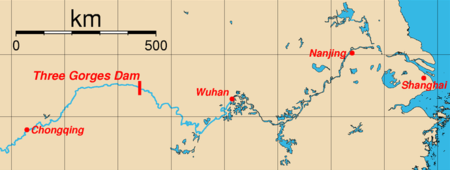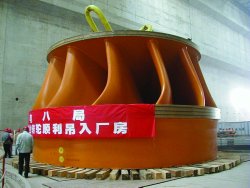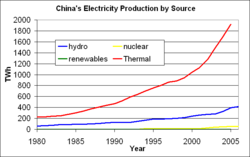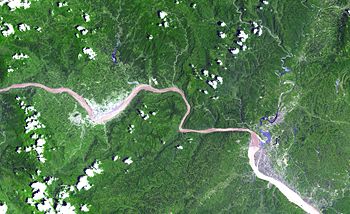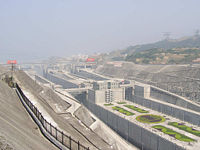Three Gorges Dam
2008/9 Schools Wikipedia Selection. Related subjects: Engineering
| Three Gorges Dam | |
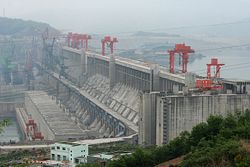 Three Gorges Dam |
|
| Official name | 长江三峡大坝 |
|---|---|
| Impounds | Yangtze River |
| Creates | Three Gorges Reservoir |
| Locale | Sandouping, Yichang, Hubei, China |
| Maintained by | China Three Gorges Dam Project |
| Length | 2,335 metres (7,661 ft) |
| Height | 101 metres (331 ft) from river level (185 metres (607 ft) from sea level) |
| Width (at base) | 115 metres (377.3 ft) |
| Construction began | 1994- 12-14 |
| Construction Cost | Estimated 180 billion yuan (25 billion U.S. dollars) |
| Reservoir information | |
| Capacity | 39.3 cu km (9.43 cu mi) |
| Catchment area | 1,000,000 km² (386,102 sq mi) |
| Bridge information | |
| Carries | 598 |
| Geographical Data | |
| Coordinates | |
The Three Gorges Dam ( simplified Chinese: 长江三峡大坝; traditional Chinese: 長江三峽大壩; pinyin: Chángjiāng Sānxiá Dà Bà) is a hydroelectric river dam that spans the Yangtze River in Sandouping, Yichang, Hubei, China. It is the largest hydro-electric power station in the world. The total electric generating capacity of the dam will reach 22,500 megawatts. This is the biggest project that has been undertaken in China since the Great Wall and the Grand Canal. Several generators are yet to be installed; the dam is not expected to become fully operational until about 2011.
As with many dams, there is a debate over costs and benefits. Although there are potential economic benefits such as flood control and hydroelectric power, there are also concerns about the relocation of people who have been or will be displaced by the rising waters; siltation that could limit the dam's useful life; loss of numerous valuable archaeological and cultural sites; and the adverse effects of increased pollution upon the regional ecosystem.
Project history
The dam was originally envisioned by Sun Yat-sen in The International Development of China in 1919. In 1932 the Nationalist government, led by Chiang Kai-shek, began preliminary work on plans for a dam in the Three Gorges. Then in 1939 the Japanese military forces occupied Yichang and surveyed the Three Gorges. A design, the Otani plan, was completed for the dam. Japan intended to build after its anticipated victory over China. In 1944 involvement from the United States began when the Bureau of Reclamation engineer J.L. Savage surveyed the area and drew up a dam proposal. Around 54 Chinese engineers were sent to the U.S. for training. Some exploration, survey, economic study, and design work was done, but the government, in the midst of the Chinese Civil War, halted work in 1947.
After the 1949 communist victory, the leader Mao Zedong supported the project, but the Gezhouba Dam project was begun first and economic problems including The Great Leap Forward and the Cultural Revolution slowed progress. In 1958, after the Hundred Flowers Campaign, some engineers who spoke out against the project were imprisoned.
During the 1980s plans were revived. Pushed through by Li Peng, the dam was approved by the National People's Congress in 1992 with a record number of abstentions and dissenting votes. The construction started on December 14, 1994. The dam was expected to be fully operational in 2009, but due to additional projects such as the underground power plant with 6 additional generators, and due to the complexity of the ship lift, the dam is not expected to become fully operational until about 2011.
Scale of the project
The dam wall is made of concrete and is about 2,309 metres (7,575 ft) long, and 101 metres (331 ft) high. The wall is 115 metres (377.3 ft) thick on the bottom and 40 metres (131.2 ft) thick on top. The project used 27,200,000 cubic metres (35,600,000 cu yd) of concrete, 463,000 tonnes of steel, enough to build 63 Eiffel Towers, and moved about 102,600,000 cubic metres (134,200,000 cu yd) of earth.
When the water level is maximum at 175 metres (574 ft) over sea level (91 metres (299 ft) above river level) , the reservoir created by the Three Gorges Dam is about 660 kilometres (410 mi) in length and 1.12 kilometres (0.70 mi) in width on average, and contains 39.3 cu km (9.43 cubic miles) of water.The total surface area of the reservoir is 1045 sq km. The reservoir will flood a total area of 632 sq km of land compared to the 1,350 sq km of reservoir created by the Itaipu Dam. The Three Gorges Dam reservoir is longer than the 560 kilometres (348 mi) length of Lake Superior, but only 1.1 % of the surface area of the lake (82,400 sq km) and about 1/700 of the volume of the lake (28700 cu km).
The dam will raise the water level the third time to its designed maximium water level (175m above sea level) by the end of 2008.
Economics
When finished, the project will have cost 180 billion yuan, over 20 billion yuan less than the initial estimated budget of 203.9 billion yuan, just under 30 billion USD. This is because the calculation accounts for the effect of inflation, and the lower costs are attributed to a low inflation rate in recent years. It is estimated that the cost of construction will be recovered when the dam generates 1000 TWh of the electricity, which will be sold at the price of 250 billion yuan. This will take 10 more years after the dam starts full operation.
Sources for funding include the Three Gorges Dam Construction Fund, revenue from Gezhouba Dam, policy loans from the China Development Bank, loans from domestic and foreign commercial banks, corporate bonds, and revenue from Three Gorges Dam before and after it is fully operational, with additional charges for electricity contributing to the Three Gorges Construction Fund. The additional charges are as follows: Every province receiving power from the Three Gorges Dam has to pay an additional charge of ¥7.00 per MWh. Provinces that will not receive power from the Three Gorges Dam have to pay an additional charge of ¥4.00 per MWh. Tibet does not have to pay any additional money.
Hydroelectricity generation and distribution
Total generating capacity
The Three Gorges Dam is the world’s largest hydro-electric power station by total capacity, which will be 22,500 MW. It will have 34 generators in total. 32 of them are main generators, each with a capacity of 700 MW, and the other two are plant power generators to power another 32 generators, each with capacity of 50 MW. Fourteen are installed in the north side of the dam, twelve in the south side and the remaining six in the underground power plant in the mountain south of the dam. After completion, the expected annual electricity generation would be over 100 TWh, 18% more than originally predicted 84.7 TWh, since six more generators were added to the project in 2002.
Generators
Each of the main generators weighs about 6000 tonnes and is designed to produce at least 700 MW of power, which is enough to power a large city. The designed head of the generator is 80.6 m. The flow rate varies between 600 cu m to 950 cu m depending on the head available. The Three Gorges Dam project installs Francis Turbines. The Francis Turbine is the most efficient turbine in the world.The diameter of the turbine is 9.709/10.427m(VGS design/Alstom's design). It rotates at a speed of 75 rpm. The normal rated power of the generator is 778 MVA. The maximum power is 840 MVA. The power factor is 0.9. The generator produces electrical power at 20 kV. The outer diameter of the generator stator is 21.42/20.9m. The inner diameter is 18.5/18.8m. The height of the stator is 3.13/2.95m. It is the biggest stator in the world. The load at the bearing is 5050/5500 tonnes. The efficiency of the generator is above 90%.
The generators are manufactured by two joint ventures. One of them includes Alstom , ABB , Kvaerner and the Chinese company Haerbin Motor. The other includes Voith , General Electric, Siemens (abbreviated as VGS), and the Chinese company Oriental Motor. The technology transfer agreement was signed together with the contract. More than 8 of the 32 generators are made in China. Most of the generators are water-cooled. Some newer ones are air-cooled, which are simpler in design,manufacture and easier to maintain.
Generator installation progress
The 14 generators in north side of the dam have already been installed. The first one (No.2 ) started to power on July 10, 2003. The last one (No.9) started to power on September 7, 2005. All the 14 generators first ran to full power (9800 MW) on October 18, 2006 after the water level had been raised to 156 m.
The first generator (No. 22) in the south side of the dam started working on June 11, 2007. Three generators on the south side of the dam are currently being installed, with another 9 already completed. The sixth generator in the south side (No. 17) started working on December 18, 2007. It brought the total capacity of the dam to 14.1 GW, surpassing the generating capacity of Itaipu (14.0 GW), to become the largest hydroelectric power plant in the world. The seventh generator in the south side (No. 17) started working on December 27, 2007.The eighth generator in the south side (No. 24) started working on April 25, 2008. The nineth generator in the south side (No. 19) started working on June 18, 2008.The total capacity of the plant is currently at 16.20 GW. The underground power plant and its six generators are still under construction. The Three Gorges Dam project also sets the record of having most generators being installed in one year (2007), that is 7 units with a capacity of more than 5000 MW.
Total power generated
As of 12:00 am May 9, 2008 the Three Gorge Dam Project had generated over 223 TWh of electricity, more than one fifth of the 1000 TWh it needs to generate to cover the cost (see Economics section).
| Year | Number of installed units |
GWh |
|---|---|---|
| 2003 | 6 | 8,607 |
| 2004 | 11 | 39,155 |
| 2005 | 14 | 49,090 |
| 2006 | 14 | 49,250 |
| 2007 | 21 | 61,600 |
| 2008 | 23 | 20,536 |
| Total | 23(32) | 228,000 |
Power distribution
The electricity generated by the Three Gorges Dam project is sold to the State Grid Corporation and China South Power Grid Corporation at a rate of ¥250 per MWh ($35.7 US). Nine provinces and two cities consume the power from it, including Shanghai.
The power distribution and transmission of the Three Gorges Dam project cost about 34.387 billion Yuan. It was completed in December 2007, one year ahead of time.
Power is sent in three directions. The 500 kV DC transmission line to the East China Grid has a capacity of 7,200 MW. There are three 500 kV DC transmission lines: HVDC Three Gorges-Shanghai(3,000 MW), HVDC Three Gorges-Changzhou(3,000 MW) and HVDC Gezhouba - Shanghai(1,200 MW). The 500 kV AC transmission line to Central China Grid has a capacity of 12,000 MW. The other 500 kV DC transmission line HVDC Three Gorges-Guangdong to South China Grid has a capacity of 3,000 MW and supplies Guangdong.
In the original plan, it was expected to provide 10% of electricity consumption in China. However, China’s demand for electricity has increased at a higher rate than was planned, and if fully operational now, it would support about 3% of the total electricity consumption in China.
Environmental Contribution of the dam
Direct reduction of air pollutant and greenhouse gas emission
According to The National Development and Reform Commission of China, it takes 366 grams of coal to generate 1 kWh of electricity in China(2006). Therefore, the Three Gorges Dam will potentially reduce the coal consumption by 31 million tonnes per year, cutting the emission of 100 million tonnes of greenhouse gas, millions of tonnes of dust, 1 million tonnes of sulfur dioxide, 370 thousand tonnes of nitric oxide, 10 thousand tonnes of carbon monoxide and a significant amount of mercury into the atmosphere. The elimination of the fossil fuel also reduces the energy consumption in mining, washing and transporting about 31 million tonnes of coal from northern China to the load centre in south and east China.
Since the Three Gorges Dam project first powered in July 10, 2003, total power production is equivalent to 84 million tonnes of standard coal and reduces carbon dioxide emission by 190 million tonnes, sulfur dioxide by 2.29 million tonnes and nitroxides by 980,000 tonnes.
Reduction of greenhouse gas due to navigation
From 2004 to 2007 there were total of 198 million tonnes of goods passed through the Three Gorges Dam ship locks. The freight capacity of the river increased 6 times and the cost of shipping reduced by 25%, compared to previous years, which reduces carbon dioxide emission by 630,000 tonnes. Comparing to highway transportation, the amount of fuel that Three Gorges Dam project saved between the year of 2004 and 2007 is equivalent to 4,100,000 tonnes of standard coal. Thus it reduces carbon dioxide emission by 10 million tones.
Aforestation
The Three Gorges Dam pushes the Chinese government to think seriously about the environmental issues associated with the dam, such as deforestation and water pollution. “The FAO’s research suggests that the Asia-Pacific region will overall, gain about 6,000 square km of forest in 2008.That is quite a turnaround from the 13,000 square km net loss of forest each year in the 1990s. The main reason is China’s huge reforestation effort. This accelerated after terrible floods in 1998 convinced the government that it must restore tree cover, especially in the mighty Yangtze’s basin” upstream of the Three Gorges Dam.
Waste management
Since the construction of the Three Gorges Dam, many waste water treatment plants have been completed to reduce the water pollution from the large populated city Chongqing and the suburban area around it. According to the ministry of environmental protection of PRC, until April 2007, there were more than 50 waste water treatment plants installed and the total capacity reached 1.84 million tonne per day. More than 65% of the waste water is treated before being dumped into the Three Gorges Dam reservoir. About 32 land sites deposit were completed and could handle 7664.5 tonne of solid waste every day.
Flood control and drought relief
The most significant function of the dam is to control flooding, which is a major problem of a seasonal river like the Yangtze. Millions of people live downstream of the dam, and many large and important cities like Wuhan, Nanjing and Shanghai lie next to the river. Plenty of farm land and the most important industrial area of China are built beside the river.
In 1954 the river flooded 47.75 million acres (193,000 km²) of land, killing 33,169 people and forcing 18,884,000 people to move. The flood covered Wuhan, a city with 8 million people, for over three months, and the Jingguang Railway was out of service for more than 100 days.
In the event of a recurrence of the 1954 flood that carried 50 billion m3 of water, the Three Gorges Dam could only divert the water above Chenglingji, leaving 30 to 40 billion m3 of flood water to be diverted. Also the dam will not protect the large tributaries such as the Xiangjiang, Zishui, Yuanshui, Lishui, Hanjiang, and Ganjiang from flooding,due to the location of the dam.
In 1998 a flood in the same area caused billions of dollars in damage. The Chinese government asked for support from its military to fight the flooding. Two thousand and thirty-nine square kilometers of farm land was flooded. The flood affected more than 2.3 million people, and 1,526 were killed.
The reservoir's flood storage capacity is 22 cubic kilometers (18 million acre feet). This capacity will reduce the frequency of major downstream flooding from once every 10 years to once every 100 years. With the dam, it is expected that major floods can be controlled. If a "super" flood comes, the dam is expected to minimize its effect.
Navigation
The installation of ship locks is intended to increase river shipping from 10 million to 100 million tonnes annually, with transportation costs cut by 30 to 37%. Shipping will become safer, since the gorges are notoriously dangerous to navigate. Each of the two ship locks is made up of 5 stages taking around 4 hours in total to complete and have a capacity of 10,000 tons. Critics argue, however, that heavy siltation will clog ports such as Chongqing within a few years based on the evidence from other dam projects.
The locks are designed to be 280 m long, 35 m wide, and 5 m deep (918 x 114 x 16.4 ft). That is 30 m longer than those on the St Lawrence Seaway, but half as deep. Before the dam was constructed, the maximum freight capacity of the river at the Three Gorges site is 18.0 million tonnes per year. From year 2004 to 2007, there were total of 198 million tonnes of freight passed through the Three Gorges Dam ship locks. The freight capacity of the river increased 6 times and the cost of shipping reduced by 25%, comparing to the previous years. The total capacity of the ship locks is expected to reach 100 million tonnes.
In addition to the canal locks, the Three Gorges Dam will be equipped with a ship lift, a kind of elevator for vessels. The ship lift will be capable of lifting ships of up to 3,000 tons. In the original plan its capacity was to be 10,000 The ship lift was not yet complete when the rest of the project was officially opened on May 20, 2006. Construction of the ship lift started in October 2007 and will be completed in the year 2014.
Relocation of local residents
The relocation of local residents is the central part of the Three Gorges Dam Project. It is considered as important as the construction of the dam. During the planning stages in the 1990s it was estimated that 1.13 million residents would be forced to relocate; new developments have doubled that number to 2.3 million. That estimate has been increased and as of 13 October 2007, 1,400,000 citizens have been displaced, which is about 1.5% of the total population of Hubei Province (60.3 million) and Chongqing City (31.44 million) where the reservoir is located. About 140,000 residents will be relocated out of Hubei province to eastern provinces and some central provinces, and the majority of the remaining people will be relocated within Hubei Province.
On October 11, 2007 Chinese state media announced that under a development plan of Chongqing city, an additional 4 million people will be encouraged to move from their homes near the dam to the Chongqing metropolitan area by the year 2020.
On one hand, the massive relocation demonstrates the Chinese government's determination and will to complete the huge project. On the other hand, there have been accusations that corruption in the government has kept residents from getting proper assistance. For instance, millions in tax money sent to the town of Gaoyang for the purpose of relocation 13,000 farmers disappeared after it was sent to the local government, and residents were denied compensation.
Criticism
Environmental impact
Of the 3,000 to 4,000 remaining critically endangered Siberian Crane, a large number currently spend the winter in wetlands that will be destroyed by the Three Gorges Dam. The dam also contributed to the functional extinction of the Baiji, the Yangtze river dolphin. In addition, populations of the Yangtze sturgeon are guaranteed to be "negatively affected" by the dam. There are high levels of pollution currently in the Yangtze. Over one billion tons of wastewater are released annually into the river. The dam will significantly decrease the river's flushing capacity and the pollution ratings will increase. For the current amount of pollution, there is an estimated cost of 2.8 billion Yuan to clean the river.
While logging in the area was required for constructionwhich adds to erosion, stopping the periodic and uncontrolled flooding of the river will lessen bank erosion in the long run. The build up of silt in the reservoir will, however, reduce the amount of silt transported by the Yangtze River to the Yangtze Delta and could reduce the effectiveness of the dam for electricity generation and, perhaps more importantly, the lack of silt deposited in the peninsula could result in erosion and sinking of coastal areas.
Effect on local culture and aesthetic values
The 600 kilometer (375 mi) long reservoir has or will flood some 1,300 archaeological sites and alter the appearance of the Three Gorges as the water level rises over one hundred meters at various locations. Cultural and historical relics are being moved to higher ground as they are discovered but the flooding of the Gorge will undoubtedly cover some undiscovered relics. Some other sites cannot be moved because of their location, size or design. For example the hanging coffins site high in the Shen Nong Gorge is inherently part of the sheer cliffs themselves.
These historical sites contain remnants of the homeland of the Ba, an ancient people who settled in the region more than 3000 years ago. One of the traditions of the Ba was to bury the dead in coffins in caves high on the cliff, some of which are submerged and others will soon be submerged.
Sedimentation
There are two hazards uniquely identified with the dam. One is that sedimentation projections are not agreed upon, and the other is that the dam sits on a seismic fault.
The Three Gorges area currently has 10% forestation, down from 20% in the 1950s. At current levels 80% of the land in the area is experiencing erosion causing about 40 million tons of sediment to slide into the Yangtze annually. The relocation of people from the reservoir area will cause further deforestation and erosion due to agricultural needs.
Excessive sedimentation can block the sluice gates which can cause dam failure under some conditions. This was a contributing cause of the Banqiao Dam failure in 1975 that precipitated the failure of 61 other dams and resulted in over 20,000 deaths. Critics believe that the Yangtze will add 530 million tons of silt into the reservoir on average per year; in time, this silt could accumulate behind the walls of the dam, clogging the turbines' entranceway. Further, the absence of silt down stream would have two dramatic effects:
- Some hydrologists think that this could make downstream riverbanks more vulnerable to flooding.
- The city of Shanghai, more than one thousand miles (1600 km) away from the dam, rests on a massive plain of sediment. The "arriving silt -- so long as it does arrive -- strengthens the bed on which Shanghai is built... the less the tonnage of arriving sediment the more vulnerable is this biggest of Chinese cities to inundation..."
The Benthic sediment build up is a cause of biological damage and reduction in aquatic biodiversity.
Induced seismicity
Also, the weight of the dam and reservoir can cause induced seismicity, which occurred, for example, with the Katse Dam in Lesotho and the Boulder Dam in the United States. The dam is already considered a possible cause of quakes in the area, just as the Zipingpu Dam is a suspect in the May 12, 2008 Sichuan earthquake.
National Security Concerns
In an annual report to the United States Congress, the Department of Defense cited that in Taiwan, “proponents of strikes against the mainland apparently hope that merely presenting credible threats to China’s urban population or high-value targets, such as the Three Gorges Dam, will deter Chinese military coercion.”
The notion that the Military of the Republic of China would seek to destroy the Dam provoked an angry response from the mainland China media. People’s Liberation Army General Liu Yuan was quoted in the China Youth Daily saying that the People’s Republic of China would be "seriously on guard against threats from Taiwan independence terrorists".
Contentious Beliefs about the Three Gorges Dam Project
- “The dam can generate up to 18.6 GW of power.” This is an out of date number. Since there were 8 more generators(6 in the underground power plant, 2 in the power station for the dam) added after the project started, the project will be able to generate about 22.5 GW of electrical power. See also “Power generation”
- “More than 4 million people have to be relocated due to the dam.” The original estimation of the number of people need to be relocated is 1.14 million. However, since the project covers a time span of 2 decades, the number is increasing. The final number won’t come out until the end of 2008, when the water level will rise to the designed highest level 175m. On October 11, 2007 Chinese state media announced that under a development plan of Chongqing city, an additional 4 million people will be encouraged to move from their homes near the dam to the Chongqing metropolitan area by the year 2020. See also "Relocation of local residents".
- “Scientists even claim that the weight of the water from the reservoir will be so heavy it will tilt the earth on its rotational axis by a slight degree.” By the physics law of conservation of momentum any movement on earth involving a redistribution of mass will change the movement of the planet by a slight degree. So theoretically, the Three Gorges Dam reservoir will change the earth’s rotational axis, but only by a slight degree that is undetectable by human beings.
- “The Three Gorges Dam creates the largest human made reservoir on the earth.” Although the Three Gorges Dam project is one of the largest dams in the world, its reservoir is much smaller than dams of similar scale. For example, the Itaipu dam, flooded 1350 square kilometres of land and the Tucurui dam, flooded 2,430 square kilometres of land. Whereas the Three Gorges Dam only flooded 632 square kilometers of land. See also "Scale of the project"
- “The Three Gorges Dam can supply 10% of China’s electricity demand.” When the dam was planned in late 1980s and early 1990s it was expected to provide 10% of electricity consumption in China. However, China’s demand for electricity has increased at a higher rate than was planned, and if fully operational now, it would support about 3% of the total electricity consumption in China. According to World Energy Outlook 2007 by International Energy Agency, China the electricity demand will rise to 4409TWh by 2015. In other words, by 2015, the fully operational Three Gorges Dam will provide 2.27% of the China’s total electricity consumption. Between 2004 and 2005 alone, Chinese electricity demand grew be 263Twh, close to thrice the expected annual output from the dam.
- “The Three Gorges Dam caused the Sichuan earthquake.” The increased load on one of the tectonic plates associated with the 2008 Sichuan earthquake in May 2008 did bear the increased load of the dam's earthworks, structure, and the filling reservoir of water. Other reservoir filling has been noted to cause induced seismicity but a direct correlation to activity of such magnitude as a 7.8 quake has not been previously recorded. While the dam may be a small contributing factor to the seismic activity, experts had agreed earlier in the decade that a significant earthquake would occur in the region in the near future, see: Signs and Prediction of 2008 Sichuan earthquake. As a worst case scenario the seismic activity was hurried along or strengthened; the dam is not the sole source of the 2008 earthquake. However, engineers for the dam did believe that magnitude 6.5 to 7.0 earthquakes would be triggered by the dam.
Future projects upstream
In order to maximize the utility of the Three Gorges Dam and cut down on sedimentation from the Jinsha, a tributary of the Yangtze river, China plans to build a series of dams upstream of the Yangtze river, including Wudongde Dam, Baihetan Dam, Xiluodu Dam, Xiangjiaba Dam, and downstream of Jinsha. The total capacity of those four dams is 38,500 MW, almost double the capacity of the Three Gorges. There are also another eight dams in the midstream of the Jinsha and eight more upstream of it.
Fictional appearances
- In Max Brooks’ novel World War Z, the large artificial lake upstream of the dam is the site of the initial zombie outbreak before the war; a superstitious character suggests that the outbreak is a retribution for the destruction of ancient holy sites. Later in the novel, the Dam is overrun by zombie hordes, which make the emergency pressure release valves impossible to reach. This eventually results in the Three Gorges Dam rupturing, resulting in a massive tsunami which races to the ocean, destroying what remains of Wuhan, Nanjing, and Shanghai. This results in the outbreak of the Chinese Civil War.
- In the novel Dragon Bones by Lisa See, a murder investigation takes place at the Three Gorges Dam.
- In the video game Civilization IV the dam is a World Wonder, providing power to the entire continent.
- In the video game Command & Conquer: Generals, the dam is blown up by both the Chinese government and a terrorist organization under plot lines. (It is first blown up by the Chinese as a desperate effort to drown the terrorists with the water behind the dam, while the terrorists blow up a rebuilt dam to flood the Chinese.) The series is banned in China.
- Jia Zhangke’s film, Still Life, describes the destiny of two couples with connections to the dam.
